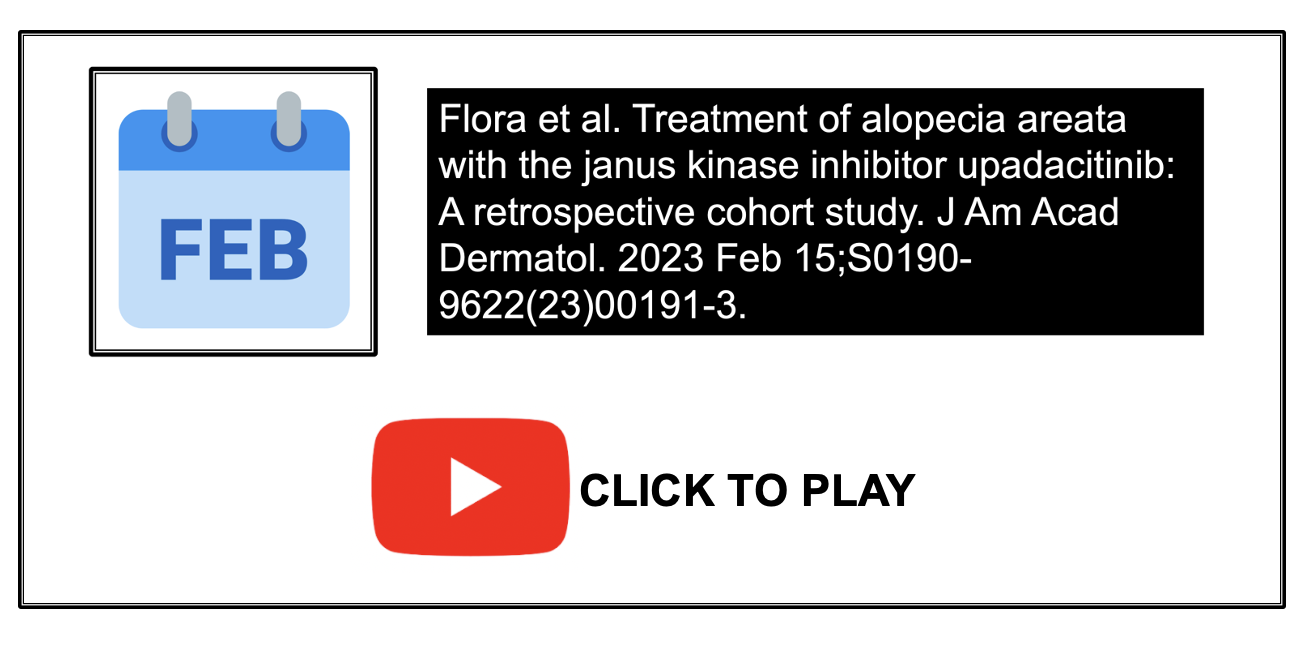Exciting Data Positions Upadacitinib (Rinvoq) as a Potential Option for Alopecia Areata
Upadacitinib (Rinvoq) May be Another Helpful JAK Inhibitor for Treating Alopecia Areata
Upadacitinib is a JAK1 specific oral inhibitor. It is FDA approved for refractory moderate to severe atopic dermatitis in those 12 years of age and over as well as ulcerative colitis, psoriatic arthritis, rheumatoid arthritis, non radiographic axial spondyloarthritis and ankylosing spondylitis.
Case reports to date have suggested that upadacitinib could be a potentially good option for treating alopecia areata. (see prior articles “Upadacitinib for Alopecia Areata”)
Flora et al 2023
Flora et al from Australia conducted a retrospective cohort study of all patients with AA treated with upadacitinib at their institution between October 2021 and July 2022.
There were 25 patients included in the study. The median age was 31 years. 7 (28%) participants were men and 18 (72%) were women. A total of 4 (16%) patients had a history of atopic dermatitis. All patients were started on an upadacitinib dose of 15 mg per day. 3 of the 25 patients (12%) had their dose increased to the 30 mg dose after 4 weeks of therapy.
The median alopecia areata SALT score reduced from 50 to 25 after 12 weeks of therapy, reducing further to a median of 5 after 24 weeks.
A Closer Look at Patients with Severe Alopecia Areata
There were 13 patients with initial SALT 50 or more. All 13 patients (100%) achieved a SALT less than 20 at week 24. 8 of 13 with an initial SALT of 50 or more (61.5%) achieved a SALT less than 10 at week 24.
The Dermatology Quality of Life Index scores also had a similar decline, from a median of 15 at the start to 8 at week 12, further reducing to 2 at week 24
Medications were well tolerated. During the first 24 weeks of therapy, no individuals encountered notable laboratory abnormalities or infectious complications, and no participants stopped receiving treatment due to adverse events.
Discussion
I really liked this study. This is pretty exciting data for upadacitinib.
It’s a small study so conclusions are somewhat limited. But 100% of patients with severe alopecia areata achieved a SALT less than 20. That’s the cut off in trials for cosmetically significant growth. Granted it’s a small number of patients who were studied - but that’s a pretty impressive number
It’s not completely fair to compare this small trial by Flora et al to the large BRAVE AA trials for baricitinib by King et al. However a few comparisons are helpful. The BRAVE AA trial had a mean SALT score of around 85 to start with - so patients in the BRAVE studies have pretty severe alopecia areata. Here, the 13 patients with severe alopecia areata had a mean SALT of 61.5 to begin with. So, patients in the Flora study with severe AA did not quite have as severe AA in the BRAVE trials. In addition, it should be noted that in the BRAVE AA trail, there were 53 % of patients with a near total alopecia. In this study, there were no patients with 95-100 % alopecia. The most severe was a single patient with a SALT 90
REFERENCE
Flora et al. Treatment of alopecia areata with the janus kinase inhibitor upadacitinib: A retrospective cohort study. J Am Acad Dermatol. 2023 Feb 15;S0190-9622(23)00191-3.
This article was written by Dr. Jeff Donovan, a Canadian and US board certified dermatologist specializing exclusively in hair loss.

